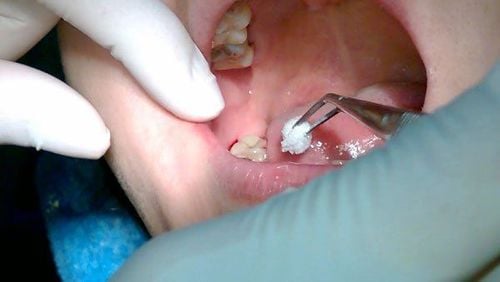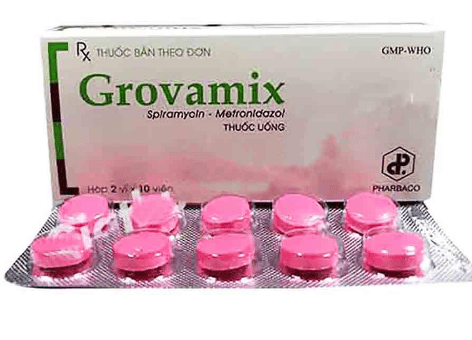This is an automatically translated article.
Parotid salivary gland stones and stenon duct stones are common conditions, accounting for about 20% of all salivary gland stones in general. Taking stenon duct stones is a treatment measure to remove stones located in the duct, limiting the risk of blockage causing inflammation of the salivary glands.1. What are stenon duct stones?
The parotid salivary gland is located at the position corresponding to the anterior and inferior region of the pineal cap, the secretions of the parotid gland pour out into a small hole located next to the 6th tooth of the upper jaw, also called the foramen of the Stenon duct.Stenonoid duct stones are a condition in which the secretions are coagulated and accumulate in a mass in the duct rather than in the gland, usually due to calcium and phosphate accumulation, it can be formed by uric acid in patients with renal failure. patients with gout. Often this buildup is caused by dehydration, weakness, reduced food intake, or anticholinergic medication.
Manifestations of stenon duct stones such as:
Pain due to stones appears suddenly when eating, chewing increases salivation. The parotid gland swells with severe pain and then collapses when saliva is released. Longitudinal palpation of the Stenon duct can detect stones. In cases where stenon duct stones cause obstruction leading to inflammation of the parotid salivary glands, it can cause swelling, heat, redness, pain in the parotid gland and may lead to fever. If stenon duct stones are not treated early, there is a risk of salivary gland blockage leading to infection, atrophy of parotid salivary glands.

Tuyến mang tai sưng là biểu hiện của sỏi ống tuyến stenon
2. Oral stenon stone removal
The treatment is done early to avoid complications that lead to the removal of the parotid gland. It is necessary to apply non-invasive treatment measures first. If failure or severe prognosis is difficult to resolve with non-interventional treatment, the indication for stone removal can be done by endoscopic stone removal or stone surgery.2.1 Endoscopic stenon stone removal Endoscopy for salivary gland stone removal in the treatment of salivary gland stones is a method performed with an ultra-thin endoscopic instrument with a small diameter of just under 1mm.
This is a painless method, so there is no need to perform anesthesia before removing the stone, safe because it limits the side effects caused by anesthetics.
The steps to endoscopically remove stenon duct stones are as follows:
First of all, it is necessary to determine the location of the stones by taking unprepared straight and inclined X-rays, taking a panorama film. Determine the state of the salivary glands before stone removal and the degree of patency of the salivary passages. By ultrasound identification of glandular tissue, radiographic contrast of the salivary tract, knowing the diameter of the canal and the extent of dilatation of the canal. If the gland function is still good, the salivary passages are open wide enough to remove the stones through the flexible endoscope. Perform endoscopic stone removal in the stenon tube with microsurgical forceps with gabion, to remove all stones. Note that this movement of stone removal needs to be done very carefully because the salivary tract is very narrow and there is a risk of injury when removing stones. This method is quite simple, so it can limit many complications that can remove stones in the duct.
2.2 Surgical removal of stones A stone removal surgery is performed when other measures have failed or are not possible. In order to limit inflammation of the salivary glands, preserve the gland.
Surgical removal of stones is indicated when there are stones in the duct, not in the case of stones in the gland.
Contraindications:
A general health condition that does not allow weakness, severe uncontrolled blood clotting disorder. Allergy to anesthetics or anesthetics does not allow surgery. The current local infection has not been stabilized. It is necessary to use stable antibiotic treatment before conducting intervention. The location of the stone is located in the gland. In this case, surgical removal of the parotid salivary glands is usually indicated. If you are taking anticoagulants, you should stop taking them at least 24 hours before surgery to limit the risk of bleeding during and after surgery.

Lấy sỏi ống tuyến stenon đường miệng thực hiện bằng phương pháp nội soi lấy sỏi hay phẫu thuật lấy sỏi
Preparation:
Performer: Surgeon with training in maxillofacial surgery and technician. Patient: The patient or family member is explained about the surgical procedure and possible complications during the treatment. Check the patient, if the patient's state is stable, proceed to anesthesia, choose the method of anesthesia with anesthesia or endotracheal anesthesia. Carry out surgery:
Disinfect all around the surgical area. Locate the stone on the stenon duct and use a suture to tie the posterior position of the stone. Incision of the mucosa and removal of the stone: Use a knife to make an incision in the mucosa of the floor of the mouth along the stenon tube at a position just above the position of the stone. Then peel and expose the stone and remove all the stones in the parotid duct. Then pump clean the duct. Hemostasis and mucosal closure, but not closure. Monitor and manage complications that occur:
During surgery:
Pay attention to complications caused by anesthetic drugs. Bleeding complications in surgery: Stop bleeding for the patient, give fluids or blood transfusion if a lot of blood is lost. Cut off the branches and branches of the nerves supplying the parotid region, which can be checked with a nerve detector during surgery. Postoperative
Postoperative bleeding: Use measures to stop bleeding. Infections: Treat with systemic broad-spectrum antibiotics against infection and proper local wound care. Removing stenon duct stones is a fairly simple intervention, but to minimize the risk of complications, the patient should be fully examined to rule out risk factors and should be performed by a trained doctor. methodically experienced.
Please dial HOTLINE for more information or register for an appointment HERE. Download MyVinmec app to make appointments faster and to manage your bookings easily.













